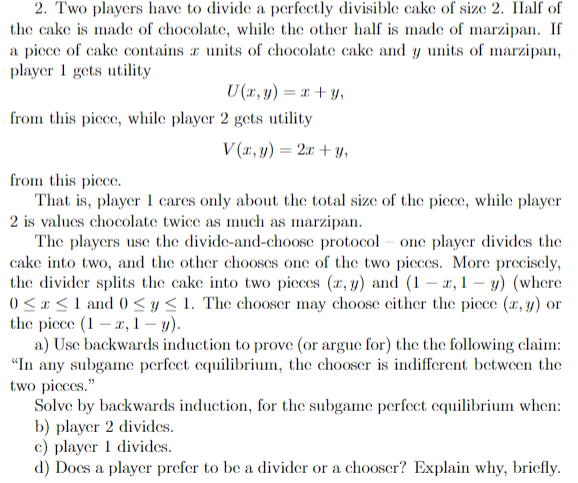2. Two players have to divide a perfectly divisible cake of size 2. Half of the cake is made of chocolate, while the other half is made of marzipan. If a piece of cake contains a units of chocolate cake and y units of marzipan, player 1 gets utility U(x, y) = x + y, from this piece, while player 2 gets utility V(x, y) = 2x+y, from this piece. That is, player 1 cares only about the total size of the piece, while player 2 is values chocolate twice as much as marzipan. The players use the divide-and-choose protocol one player divides the cake into two, and the other chooses one of the two pieces. More precisely, the divider splits the cake into two pieces (x, y) and (1-2, 1-y) (where 0≤x≤ 1 and 0 ≤ y ≤ 1. The chooser may choose either the piece (x, y) or the piece (1-2, 1-y). a) Use backwards induction to prove (or argue for) the the following claim: "In any subgame perfect equilibrium, the chooser is indifferent between the two pieces." Solve by backwards induction, for the subgame perfect equilibrium when: b) player 2 divides. c) player 1 divides. d) Docs a player prefer to be a divider or a chooser? Explain why, briefly.
2. Two players have to divide a perfectly divisible cake of size 2. Half of the cake is made of chocolate, while the other half is made of marzipan. If a piece of cake contains a units of chocolate cake and y units of marzipan, player 1 gets utility U(x, y) = x + y, from this piece, while player 2 gets utility V(x, y) = 2x+y, from this piece. That is, player 1 cares only about the total size of the piece, while player 2 is values chocolate twice as much as marzipan. The players use the divide-and-choose protocol one player divides the cake into two, and the other chooses one of the two pieces. More precisely, the divider splits the cake into two pieces (x, y) and (1-2, 1-y) (where 0≤x≤ 1 and 0 ≤ y ≤ 1. The chooser may choose either the piece (x, y) or the piece (1-2, 1-y). a) Use backwards induction to prove (or argue for) the the following claim: "In any subgame perfect equilibrium, the chooser is indifferent between the two pieces." Solve by backwards induction, for the subgame perfect equilibrium when: b) player 2 divides. c) player 1 divides. d) Docs a player prefer to be a divider or a chooser? Explain why, briefly.
Chapter4: Utility Maximization And Choice
Section: Chapter Questions
Problem 4.11P
Related questions
Question

Transcribed Image Text:2. Two players have to divide a perfectly divisible cake of size 2. Half of
the cake is made of chocolate, while the other half is made of marzipan. If
a piece of cake contains a units of chocolate cake and y units of marzipan,
player 1 gets utility
U(x, y) = x + y,
from this piece, while player 2 gets utility
V(x, y) = 2x+y,
from this piece.
That is, player 1 cares only about the total size of the piece, while player
2 is values chocolate twice as much as marzipan.
The players use the divide-and-choose protocol one player divides the
cake into two, and the other chooses one of the two pieces. More precisely,
the divider splits the cake into two pieces (x, y) and (1-x,1- y) (where
0≤x≤ 1 and 0 ≤ y ≤ 1. The chooser may choose either the piece (x, y) or
the piece (1-2, 1-y).
a) Use backwards induction to prove (or argue for) the the following claim:
"In any subgame perfect equilibrium, the chooser is indifferent between the
two pieces."
Solve by backwards induction, for the subgame perfect equilibrium when:
b) player 2 divides.
c) player 1 divides.
d) Does a player prefer to be a divider or a chooser? Explain why, briefly.
Expert Solution
This question has been solved!
Explore an expertly crafted, step-by-step solution for a thorough understanding of key concepts.
This is a popular solution!
Trending now
This is a popular solution!
Step by step
Solved in 5 steps

Knowledge Booster
Learn more about
Need a deep-dive on the concept behind this application? Look no further. Learn more about this topic, economics and related others by exploring similar questions and additional content below.Recommended textbooks for you



